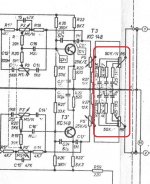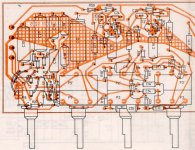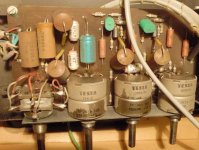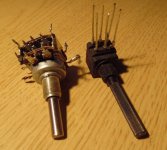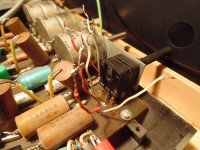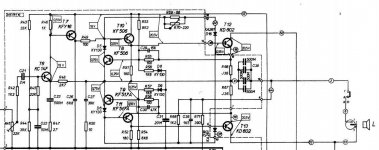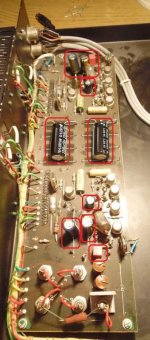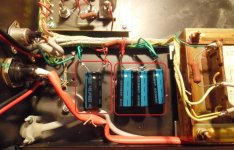Hi!
One of my friend asked me to fix this old 2 x 15W Tesla amp.
The problem is some very loud cracking noise when turning the volume pot but only at the right channel.
And it's only produced for few seconds after switch on and off. After a half minute it is almost
disappearing or the noise is much smaller. Could somebody help me?
Is there a typical background for that? What should I measure/check?
I checked the PS (which is a single supply DC 40V) and the OS outputs but they seem alright.
There are 4 stereo pots before the OS:
P2/P2': bass (2x100k)
P3/P3': treble (2x100k)
P5/P5': balance (2x25k)
P6/P6': volume (2x50k)
My first thought was simply put a new volume pot but I am confused because this P6 pot has too many legs (twice as I thought).
I attached the schematic, the pcb layout and a real photo. I marked the confusing part with a red frame on the schematic.
Does somebody know what this could be with those 3 RCs connected to the volume pot..?
The position numbers are not clearly visible for these RCs, they are:
C18, 19, 20 + R23, 24, 25 and their apostrofed pairs for the other channel...
As you can see on the pcb layout and on the photo it has the normal 2x3 legs facing the pcb panel
and has 2x3 extra legs which are connected via wires to the pcb to the RCs.
Thanks in advance!
One of my friend asked me to fix this old 2 x 15W Tesla amp.
The problem is some very loud cracking noise when turning the volume pot but only at the right channel.
And it's only produced for few seconds after switch on and off. After a half minute it is almost
disappearing or the noise is much smaller. Could somebody help me?
Is there a typical background for that? What should I measure/check?
I checked the PS (which is a single supply DC 40V) and the OS outputs but they seem alright.
There are 4 stereo pots before the OS:
P2/P2': bass (2x100k)
P3/P3': treble (2x100k)
P5/P5': balance (2x25k)
P6/P6': volume (2x50k)
My first thought was simply put a new volume pot but I am confused because this P6 pot has too many legs (twice as I thought).
I attached the schematic, the pcb layout and a real photo. I marked the confusing part with a red frame on the schematic.
Does somebody know what this could be with those 3 RCs connected to the volume pot..?
The position numbers are not clearly visible for these RCs, they are:
C18, 19, 20 + R23, 24, 25 and their apostrofed pairs for the other channel...
As you can see on the pcb layout and on the photo it has the normal 2x3 legs facing the pcb panel
and has 2x3 extra legs which are connected via wires to the pcb to the RCs.
Thanks in advance!
Attachments
Last edited:
That is a special volume control, with an "integrated" loudness -or physiologically corrected- volume adjustment caracteristics. I remember repairing some of those years ago, those pots were pretty crap quality ones, developing dropouts ,cracking a lot at different positions.
But the problem you described indicates to me, that there is a leaking coupling capacitor in the vicinity, (most likely at the input of the power amp section) causing DC present on the pots wiper, that is what causing the slowly disappearing cracking, so you should check for DC voltage present at the legs of the volume pot.
Also you should replace that volume control with a standard 2x50k standard audio taper (volume control type) one,(disconnect all those RC elements from the tap points) that should solve your problem, but you will loose the loudness control function of it, -which is pretty much useless anyway.
But the problem you described indicates to me, that there is a leaking coupling capacitor in the vicinity, (most likely at the input of the power amp section) causing DC present on the pots wiper, that is what causing the slowly disappearing cracking, so you should check for DC voltage present at the legs of the volume pot.
Also you should replace that volume control with a standard 2x50k standard audio taper (volume control type) one,(disconnect all those RC elements from the tap points) that should solve your problem, but you will loose the loudness control function of it, -which is pretty much useless anyway.
Last edited:
I cheked the DC levels and they looked good.
A checked the signal before and after the volume pot and it looks like it will be a simple pot problem,
because before the pot the signal looks ok and after the pot as I turn it the cracking is visible.
I also tried to remove the lodness RCs but it remained so now I'll get it out...
BTW: how this loudness works? What kind of legs are they using inside the pot?!
A checked the signal before and after the volume pot and it looks like it will be a simple pot problem,
because before the pot the signal looks ok and after the pot as I turn it the cracking is visible.
I also tried to remove the lodness RCs but it remained so now I'll get it out...
BTW: how this loudness works? What kind of legs are they using inside the pot?!
The owner just said that there is one more problem with it but it can be hard to catch:
after an hour of using it also one of the channels starts to generate some sizzleing noise
for 5-10 seconds and that a big poping noise is coming and then it goes on in a normal way.
This could be also some elco cap thing..? Dragonweed did you have some similar thing to fix those days maybe..?
after an hour of using it also one of the channels starts to generate some sizzleing noise
for 5-10 seconds and that a big poping noise is coming and then it goes on in a normal way.
This could be also some elco cap thing..? Dragonweed did you have some similar thing to fix those days maybe..?
The sizzling and popping noise might be generated by a dying electrolytic, or a failing semiconductor (transistor or diode,- there are no IC-s in that amp), but that will be trickier to find. If you have a scope it might be easier, if not, just replace the suspicious elco-s and semis in the noisy channel (there are not too many of them I guess). Start with the preamp, then tone control section, the problem is very likely there somewhere
If you turn the volume pot down to zero is it still doing it? If yes, then it is coming from the power amp stage
If you turn the volume pot down to zero is it still doing it? If yes, then it is coming from the power amp stage
Last edited:
Thanks!
Today I managed to reproduce the error: indeed after an hour there was some sizzling and then a medium loud bump.
Thanks to to sizzling phase I had time to set the volume pot to zero and the noise was independent so the error will be somewhere in the OS section.
After that it was working in a normal way and after a half an hour a 2nd bump was produced but this time much faster...
I didnt had the time to react or to check which channel it happened at... I attach the schematic. My question this can really caused by semis as well or it is 90% sure that its prodeuced by an elco?
Today I managed to reproduce the error: indeed after an hour there was some sizzling and then a medium loud bump.
Thanks to to sizzling phase I had time to set the volume pot to zero and the noise was independent so the error will be somewhere in the OS section.
After that it was working in a normal way and after a half an hour a 2nd bump was produced but this time much faster...
I didnt had the time to react or to check which channel it happened at... I attach the schematic. My question this can really caused by semis as well or it is 90% sure that its prodeuced by an elco?
Attachments
As far as I'm aware, Tesla electrolytics don't have a particularly good reputation and are probably best replaced by good-quality modern parts in any case (axials may be a bit of a problem though). There's only 8 per channel in the power amp anyway (and yes, you can replace those 4 500µ ones with one 2200µ, preferably rated at least 40 V). What you describe may fit the occasional hole in the dielectric layer being plugged by leakage current. A bad semiconductor with internal contact problems or a bad solder joint can, however not totally be ruled out either.
- Status
- This old topic is closed. If you want to reopen this topic, contact a moderator using the "Report Post" button.
- Home
- Amplifiers
- Solid State
- Tesla NZC-431 Repair
